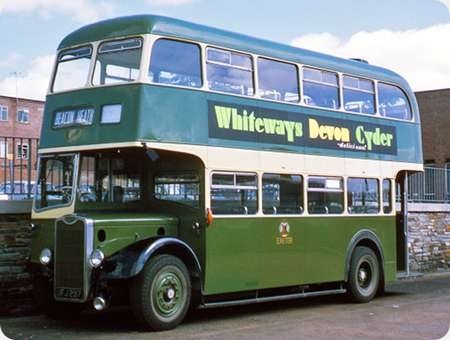Exeter Corporation – Guy Arab – UFJ 297 – 57
Exeter Corporation
1957
Guy Arab IV
Park Royal H31/26R
Until 1956, Exeter Corporation’s only experience of the Gardner engine came with five Bristol GO5G buses of 1935. All had gone by 1948. Exeter did not accept any utility buses until 1944, but these were seven Daimler CWA6, and ten more of the same type followed in 1945. It appeared that the Corporation had set its face determinedly against the Guy Arab. In the years up to 1950, the Daimler CWD6/CVD6 rather than the Gardner powered alternative then became the favoured chassis, a total of thirty three entering service, apart from a batch of seventeen Leyland PD2/1 in 1947. After 1950, Exeter did not order any new buses until 1956, when the Corporation turned unexpectedly to the 6LW powered Guy Arab IV, variously with Massey, Park Royal and MCW bodywork. Guy Arab IV UFJ 297, No. 57 of 1957 is seen in Exeter Bus Station in the early summer of 1970, shortly after the sale of the Corporation’s passenger transport interests to the National Bus Company, which sadly occurred in April of that year. The supremely elegant H31/26R Park Royal body style with the deeper saloon windows is essentially similar to those being delivered to East Kent on tin fronted Arab IVs at that time, and it amply illustrates the catastrophic collapse in design standards from the sublime to the ridiculous that subsequently afflicted that formerly respected coachbuilder. Apart from a delivery of five Leyland PD2/40 in 1958, Exeter stayed with the Arab until 1960, when Guy, besotted with its new wonder Wulfrunian, withdrew the Arab from the market.
Photograph and Copy contributed by Roger Cox
13/06/17 – 06:39
I didn’t know Guy withdrew the Arab from the market in 1960. Its absence can’t have lasted long, as Lancashire United received Arab IVs in 1960, 1961 and 1962, and Arab Vs from 1963 onward.
Peter Williamson
13/06/17 – 09:12
Yes, Guy did take the Arab off the market, convinced that the Wulfrunian would conquer in its place. In 1960 the Guy company collapsed and Jaguar took over the Wolverhampton business. It was pressure from established aficionados of the marque, together with the almost universal rejection of the troublesome Wulfrunian that then quickly led to the reinstatement of the Arab.
Roger Cox
13/06/17 – 13:59
The slightly earlier Massey bodied Arab (superbly maintained by Wyvern Omnibus Ltd) appeared at the GWR (Gloucestershire & Warwickshire Railway) 1940s weekend earlier in the year. The crest and name are particularly impressive. The photos were taken by Mr Ray Phillips aka "Ray the Spiv", sometimes seen on wanted posters at 1940s events!
Andrew Gosling
17/06/17 – 10:04
Magnificent bus, and what sound-effects! Colin Shears told me that when faced with the choice of which of the Massey-bodied batch to preserve he went straight for TFJ 808, as it had the most musical gearbox of the lot. What a pity, though, that none of the Park Royals survived. A question: was the Arab IV available to the end, or was it replaced by the Arab V?
Ian Thompson
18/06/17 – 06:52
Firstly, I should correct the date I gave in my comment above. Guy went into receivership and was bought by the Jaguar Group in 1961, not 1960 – apologies. Turning to Ian’s enquiry, the Arab V, which was introduced after the Jaguar takeover, was fundamentally a Mark IV with a chassis frame lowered by 2½ inches enabling the forward entrance to be accessed by just two steps instead of the three usual on conventional front engined chassis. Thus the Mark IV was simply supplanted by the Mark V in production until the last Mark Vs were delivered to Chester in 1969.
Roger Cox
19/06/17 – 07:18
Since this is a discussion emanating from a 27-foot Arab IV, it should be pointed out that at that length the Arab IV was actually supplanted by the Daimler CCG6 (Chesterfield at least having a Guy order transferred to Daimler), while Guy concentrated on 30-foot Arabs and dreamed of Wulfrunian orders. The 27-foot Arab V came into being eventually, but I understand only one batch were built – for Cardiff.
Peter Williamson
20/06/17 – 07:15
There is a bit more history behind the Daimler CCG6. From 1959, Daimler tried to get more of the ‘non preselector’ market by introducing the CSG6 with the David Brown synchromesh gearbox. The David Brown box proved to have reliability problems, and when Jaguar bought the Guy company, the indestructible Guy constant mesh gearbox replaced the troublesome David Brown unit in the CCG5/6 models, which, like the Arab V, were available from 1962.
Roger Cox
Quick links to the - Comments Page - Contact Page - Home Page
Comments - Please note: The comments facility is not currently available. Please see the home page for updates.
Please Note if you want to send a photograph with your comment please use the Contact Page by clicking here or send as an attachment via email.


